Namhae Island – and specifically Darangee Village, a small hamlet featuring over 100 levels of rice terraces on a steep mountain slope against the open sea – caught our attention three weeks ago when we discovered CNN s article ‘50 Beautiful Places to Visit in Korea’.
Dubbed ‘treasure island’, there’s more than enough to keep you on the move for two to three days making it the perfect weekend getaway.
It’s only a two hour drive from Geoje if you follow Route 14 onto 77 (less if you take the recommended GPS route onto the main highway). Our route is a narrow, windy coastal road which is great for sightseeing, but perhaps not so good for those prone to car sickness. There’s plenty of time for that when you drive the coastal scenic route of the island!
Our pick of things to see
Namhae Bridge
For some, a bridge is just a bridge. Not for the Elliott’s. We love a good bridge and the Koreans seem to know how to construct one well. Built in 1973, it spans a total length of 660 meters and is 80 metres high. Vantage points from either end (island and mainland) are hard to come by so it’s worth parking the car to inconvenience other drivers for a quick moment to steal a proper glimpse and take a photo.
Coastal Scenic Route
This is 302kms of windy, technicolour landscape, mountains and ocean. Dotted with pretty fishing villages, pristine white sandy beaches and lush – almost tropical – greenery, there’s a view around every bend. The roads are narrow though and there is a tendency for many drivers to cut corners and drive down the centre, so take your time! If you are prone to car sickness, you may want to take something prior to leaving.
Garlic Land
Korea is the world’s largest producer and consumer of garlic and Namhae is the largest and most famous producing region. It only seems fitting then that they have a whole ‘land’ to teach you about the health and dietary benefits of eating the stuff. Given the reek of garlic abounds, it’s not surprising to find that seven cooked cloves are recommended each day.
GPS Address: Gyeongsangnam-do Namhae-gun I-dong-myeon Dajeong-ri 971
Hilton Namhae Golf Resort
This seems to feature on every article we’ve read about the island. Naturally, we checked out the cost of staying and at $505 a night starting price, decided there was better value and experience to be had in a local pension. Turns out, this was a good call.
We did not feel that the resort’s modern architecture fit at all well with the landscape. The gardens were untidy and the facilities limited. We pulled up early afternoon hoping to enjoy a cocktail on the deck only to find this wasn’t an option. Arms crossed. No deal.
Darangee Village
The reason we’d come – to see the rice terraces made famous after it appeared on a popular commercial apparently. The rice fields comprise 108 steps created on a steep hill and right to the cliff edge. A path has been created to enable you to walk to the very bottom, including out onto Gacheon rock, which is the guardian rock of the village (you’ll see Rob sitting on it below).
In a word, this view was breathtaking. Knowing that local villagers (most are elderly and walk at a 90 degree angle, so fused are their backs from working a lifetime in the fields) built and tend these every day has you appreciate the view even more so.
In April, you can organise to work with locals in planting and sowing the top fields. It’s extremely dirty work, but would be an amazing experience.
GPS Address: 672 Nammyeon-ro, Nam-myeon, Namhae, Gyeongsangnam-do
American Village
Built to lure Koreans back from the US post war, American village sits in the mid-south of the island. This tree-lined village features a towering American eagle and Statue of Liberty, together with very US-looking homes. The Village overlooks Aenggang Bay and is quite secluded. A somewhat quirky and unexpected feature of the island.
GPS Address: 947-1 Yongso-ri, Idong-myeon, Namhae-gun, Gyeongsangnam-do, South Korea
Sangju and Songjeong Beaches
Only a ten minute drive apart, these are recognised as the best on the island, and for good reason. Pristine, wide, sandy beaches with clear blue waters. Sangju Beach was flanked by large trees making it a perfect option to park under the shade and still swim. Both beaches had great amenities – drinks, icecream and toilets. Unlike our Geoje beaches, bins are provided and these are extremely clean.
Both are located on the south eastern side of the island.
I found a Korean review of the beaches that said:
“Sangju Beach is like a gorgeous woman, while Songjeong Beach is more like a shy young lady”.
Okaaay.
German Village
This Village was created to lure back and provide subsidies for Korean miners and nurses who were sent to Germany by the government in return for financial aid during some of Korea’s poorest years in the 1960s and 1970s.
According to an article we read, Korea recognises these citizens as its ‘biggest patriots in history’ and that the country has not recognised them enough for their sacrifice. Once they left Korea, they weren’t able to return for years or decades or see their families. Thousands of workers apparently went to Germany at that time.
A second village is now being built in Sancheon.
Namhae’s German Village has cobblestone streets and white and orange houses with German designs,
Overlooking Mulgeonhang Port, the area is full of pensions and restaurants selling German produce, and is a great location to stay (not far from the above beaches either). They hold a huge festival for Oktoberfest – something the Elliott’s will be attending, if we can ever find information on exactly when it is!
We stopped for lunch – German sausages and beer of course – with a sensational view.
Mulgeonghang Port
You can’t expect to travel anywhere there is water without Rob stopping at almost every port in the search for a charter boat (and endless pontificating about the types of fish you can catch – yawn!).
This small fishing port is also famous for its forest. Three hundred years ago, the local people started planting trees along the coast as a windbreaker against the sea winds and waves so as to attract schools of fish into quieter covers. The trees are now some 30 metres wide along 1,500 metres of coastline and are an official monument.
At the port you can hire a fishing boat. The daily rate apparently ranges between 150,000 won and 250,000 won. For a two to three hour rental, the fee is between 50,000 to 100,000 won per person (according to a website review we found). Fees are cash only.
Whilst Rob didn’t get to fish, here are a couple of options for next time:
Daribangho Boat +82 55 867 3416 (Korean)
Namhae Changjo Naksi 010 9515 6130 (Korean)
Samcheonpo Naksi +82 55 867 4554 (Korean)
Accommodation
Finding accommodation online is not easy. Whilst there is a plethora of pensions and hotels all over the island, almost none have a website or feature on a booking site.
We happened to find ‘Whales Dream Villas’ (17-1, Bitdamchon-gil, Nam-myeon, 668-863 Sŏn’gu-r) online: http://goraedream.com/about-us/?lang=en. We stayed in ‘Free Willy’ (and yes, I’m going to leave the obvious jokes alone).
Owned by a young family and run by his mother, it ironically sat amongst dozens of other pensions and villas on a hillside with panoramic views of the coastline. He spoke very good English and I suspect does very well by catering – almost exclusively – to the international clientele. Note; the mother speaks no English so it’s a game of charades on the most part to communicate but all part of the charm and fun.
Breakfast was included in our tariff. It involved wandering downstairs to the small kitchen and helping yourself to baked potato, broccoli, hard boiled eggs, sliced tomato, fruit, juice, coffee and toast. The elderly woman insisted that Rob take a baked potato which he later hid in our esky rather than leave on the breakfast tray for fear of offending her!
That said, there were a number of great pensions in this area which you could also try. I’ve included photos below (click on the photo to enlarge):
These pensions were in – or very close to – German Village.
Here’s another I have found close to Mijo in the south east (and close to the beaches):
Pygmalion Pension
1299-2 Songjung-ri, Mijo-myun,
Namhae-gun, Kyungsannam-do, Korea
T: +82 103152-3386
W: http://epygmalion.com
Dining
Where we stayed, the dining options were limited. The village along the shoreline had one Japanese restaurant only with a raw eel speciality (um, no thanks). We actually had to travel the 7kms back to the Hilton to eat, which was not ideal or what we were hoping for. Our tip to anyone else travelling is to ask about restaurants within walking distance (or a short drive) and if you think options will be limited, pack your lunch and something for dinner. In hindsight, we wished we done just that – or packed a BBQ – and eaten on our deck. After all, we had million dollar views.
Still to see
We didn’t get to Mijohang Port (famous for fishing), Haeoreum Art Village or the Geumsan Boriam Temple – all sites we’re saving for the next visit.
Next Weekend?
We’re off to Seoul to see the Lotte Giants play baseball. Yeeha!

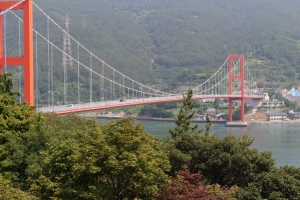



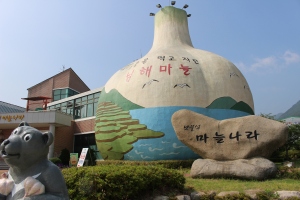





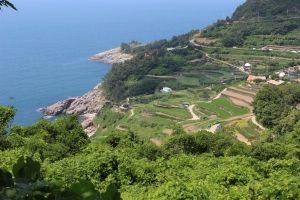
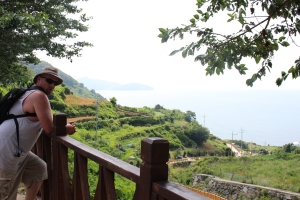

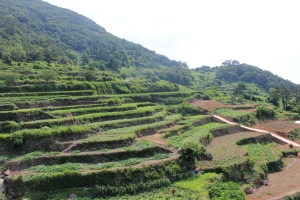
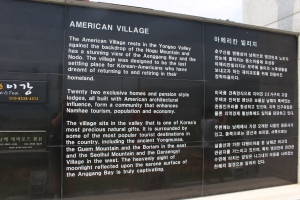
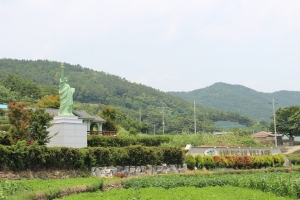

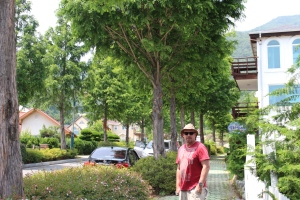



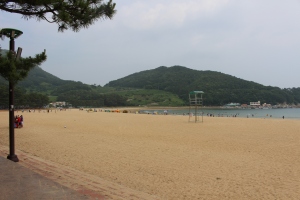

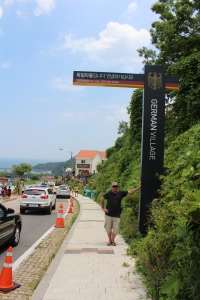



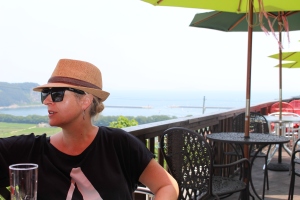



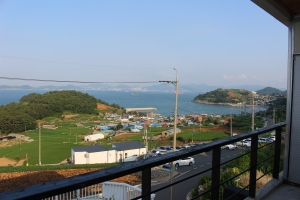



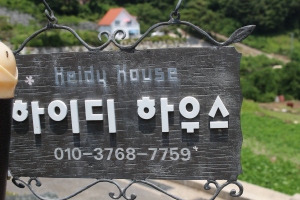




loved reading it Jodie
LikeLike
WOW, great review, thank you so much!
LikeLike
Great info, Jody. This is one place we haven’t been yet. You’ve inspired me to check it out some weekend-:))
LikeLike